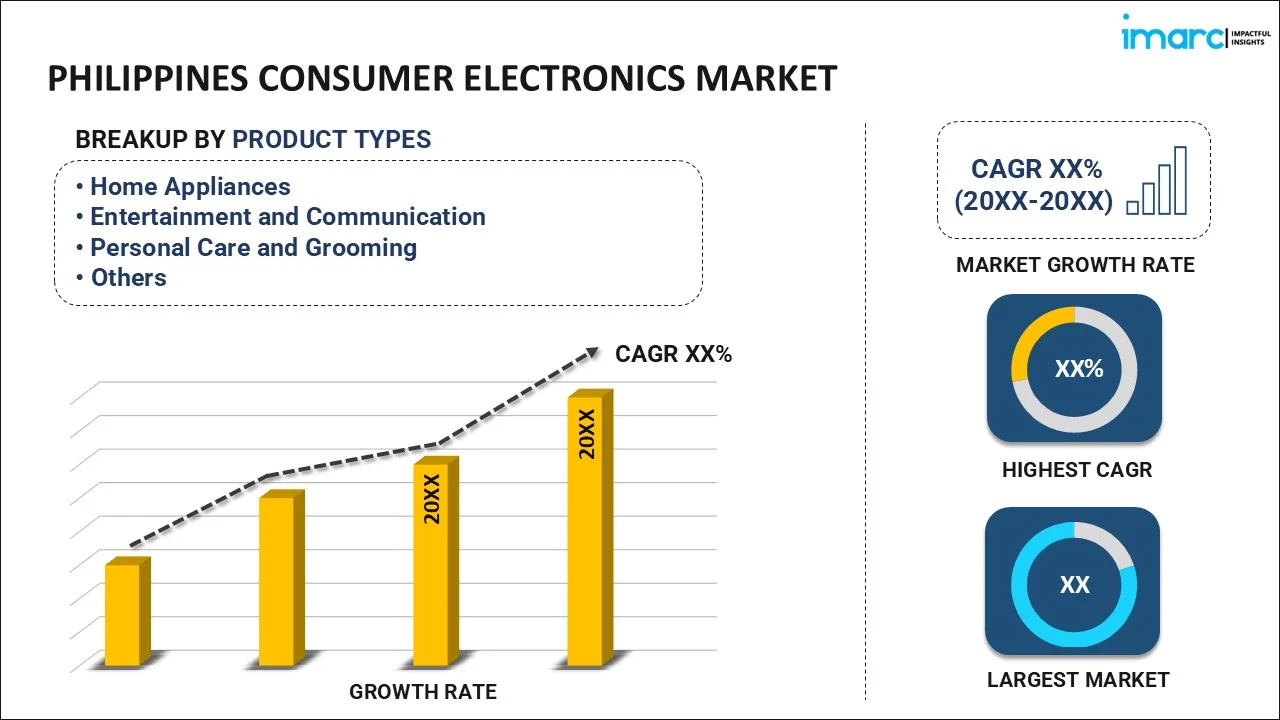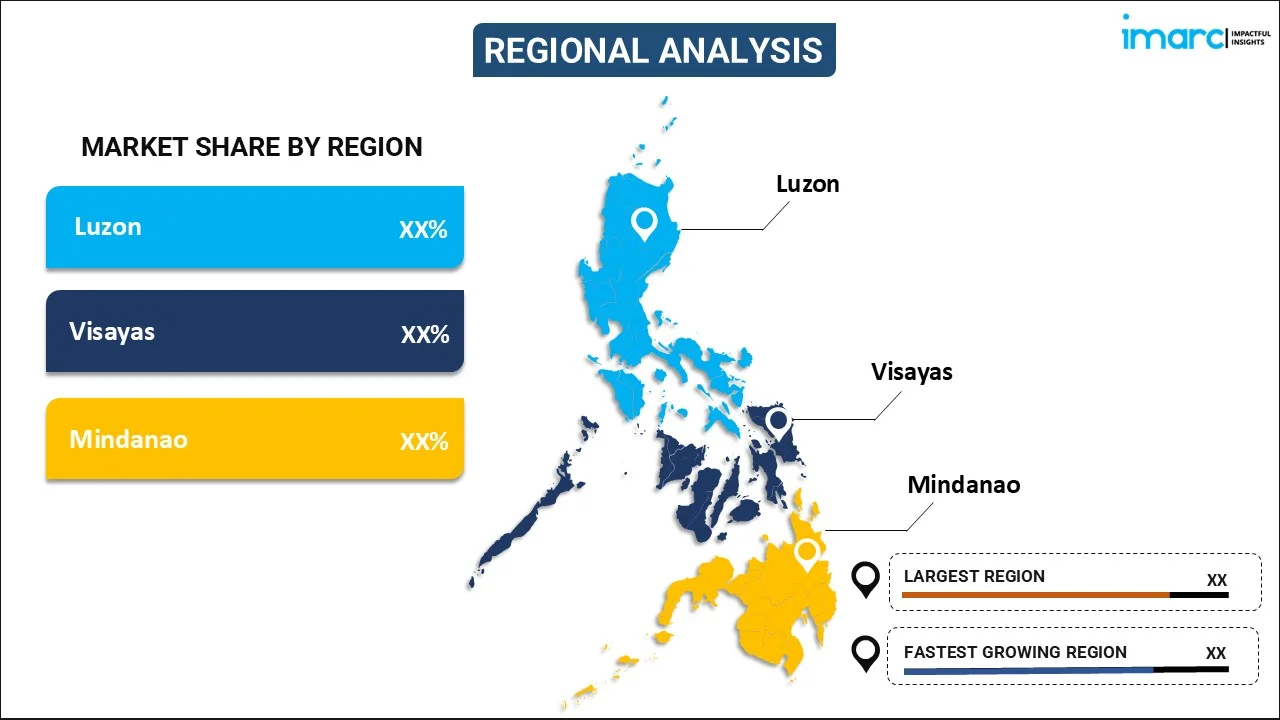
Philippines Consumer Electronics Market Size, Share, Trends, and Forecast by Product Type, Category, End-Use, Distribution Channel, and Region, 2025-2033
Philippines Consumer Electronics Market Overview:
The Philippines consumer electronics market size reached USD 10.24 Billion in 2024. Looking forward, IMARC Group expects the market to reach USD 17.48 Billion by 2033, exhibiting a growth rate (CAGR) of 6.14% during 2025-2033. The market is experiencing strong growth, driven by increasing smartphone penetration, rising demand for smart home devices, and the growing popularity of e-commerce platforms for purchasing electronics across urban and rural areas.
|
Report Attribute
|
Key Statistics
|
|---|---|
|
Base Year
|
2024 |
|
Forecast Years
|
2025-2033
|
|
Historical Years
|
2019-2024
|
| Market Size in 2024 | USD 10.24 Billion |
| Market Forecast in 2033 | USD 17.48 Billion |
| Market Growth Rate (2025-2033) | 6.14% |
Philippines Consumer Electronics Market Trends:
Rising Smartphone Penetration and Digital Connectivity
The growing use of smartphones is propelling the Philippines' consumer electronics market expansion. The demand for reasonably priced, feature-rich gadgets is being driven by the nation's youthful, tech-savvy audience. This trend is currently supported by new models and reduced pricing. According to latest industry reports by the International Trade Administration, the mobile device market constitutes over 55% of all consumer electronics related spending in Philippines. Around 44 million of the 100 million population own smartphones and Filipinos spent 10 hours on an average online per day. Urban consumers are shifting to high-end and mid-range devices equipped with advanced features including 5G which in turn is propelling the market demand. The growing reliance on mobile apps for learning, gaming, and payments is a key factor supporting the demand for smartphones. Apart from this, the implementation of government programs to increase digital literacy and expanding internet access are also contributing to the Philippines consumer electronics market growth. Sales of smartphones are propelled by the growing popularity of mobile streaming services as users seek devices with greater quality and larger screens for on-the-go entertainment and content consumption. Professionals are investing in smartphones with productivity-enhancing capabilities due to businesses' growing dependence on mobile platforms, which is intensifying demand for gadgets that can multitask and run sophisticated apps.
Growing Demand for Smart Home Devices
The advanced technology, energy economy, and convenience are becoming highly important to Filipino homes, which is driving up demand for smart home appliances. Smart speakers, automated lighting controls, and security cameras are embraced by urban families to improve their living environments. Both domestic and international manufacturers are expanding access to the Internet of Things (IoT) enabled devices, including environmentally friendly refrigerators and air conditioners, by offering affordable solutions tailored to Filipino lifestyles. These gadgets are becoming progressively appealing with the incorporation of voice-activated platforms such as Google Assistant and Amazon Alexa. The need for modern living and growing disposable incomes are making smart home technology a major key factor for the Philippines consumer electronics market share. The increasing prevalence of remote work and online education has heightened demand for smart appliances that enhance productivity and connectivity, such as Wi-Fi-enabled desks, smart printers, and advanced routers. Retailers' improved affordability strategies and flexible financing options have made smart home solutions more accessible, bridging budgetary gaps for consumers... Health-conscious individuals are adopting smart appliances with health-focused features, including refrigerators that track food freshness and air purifiers with real-time pollution monitoring, uplifting the market demand.
E-Commerce and Online Retail Expansion
The Philippine consumer electronics market is undergoing transformation driven by the rise of e-commerce. As per latest industry reports, the consumer electronics market in the Philippines is expected to grow by 0.02% during 2025-2029, reaching a market volume of USD 8023.0 Million in 2029. Online platforms such as Lazada and Shopee are providing a wide range of devices that are easily accessible and reasonably priced, which further fueling the demand for consumer electronics. In economically underserved areas, an extensive variety of customers are drawn in by flash sales, discounts, and installment payment plans. The ease of home delivery and intuitive user interfaces are motivating Filipinos to make a switch to online shopping. The growing use of digital wallets and Buy Now, Pay Later (BNPL) alternatives is making high-value electronics transactions easier, creating a positive Philippines consumer electronics market outlook. Customers are becoming highly interested in new devices which are released exclusively on an online platform, appreciating the easy e-commerce which is used to purchase the newest technology without visiting the stores. Escalating demand for consumer electronics in the online market and social media integrations with e-commerce platforms are encouraging direct customer participation and utilizing influencer promotions and livestream sales.
Philippines Consumer Electronics Market Segmentation:
IMARC Group provides an analysis of the key trends in each segment of the market, along with forecasts at the country level for 2025-2033. Our report has categorized the market based on product type, category, end-use, and distribution channel.
Product Type Insights:

- Home Appliances
- Large Electronics Appliances
- Refrigerators
- Air Conditioners
- Washing Machines
- Air Purifiers
- Others
- Small Electronic Appliances
- Microwave Ovens
- Food Processors
- Electric Fans
- Vacuum Cleaners
- Others
- Large Electronics Appliances
- Entertainment and Communication
- Televisions
- Mobiles and Smartphones
- Laptops and Computers
- Audio and Video Players
- Cameras
- Speakers
- Video Games
- Others
- Personal Care and Grooming
- Wearables
- Smartwatches
- Headphones
- Earphones and Earbuds
- Others
- Hair Care Devices
- Hair Straightener
- Hair Curler
- Hair Dryer
- Others
- Beauty Devices
- Face/Skin Care Devices
- Hair Removal Devices
- Nail Care Devices
- Others
- Wearables
- Others
The report has provided a detailed breakup and analysis of the market based on the product type. This includes home appliances (large electronics appliances and small electronic appliances), entertainment and communication (televisions, mobiles and smartphones, laptops and computers, audio and video players, cameras, speakers, video games, and others), and personal care and grooming (wearables, hair care devices, beauty devices, and others).
Category Insights:
- Smart
- Conventional
A detailed breakup and analysis of the market based on the category have also been provided in the report. This includes smart and conventional.
End-Use Insights:
- Residential
- Commercial
The report has provided a detailed breakup and analysis of the market based on the end-use. This includes residential and commercial.
Distribution Channel Insights:
- B2B
- B2C
- Online
- Company-owned Websites
- E-commerce Websites
- Offline
- Supermarkets/Hypermarkets
- Specialty Stores
- Other Retail Stores
- Online
A detailed breakup and analysis of the market based on the distribution channel have also been provided in the report. This includes B2B and B2C (online and offline).
Regional Insights:

- Luzon
- Visayas
- Mindanao
The report has also provided a comprehensive analysis of all the major regional markets, which include Luzon, Visayas, and Mindanao.
Competitive Landscape:
The market research report has also provided a comprehensive analysis of the competitive landscape. Competitive analysis such as market structure, key player positioning, top winning strategies, competitive dashboard, and company evaluation quadrant has been covered in the report. Also, detailed profiles of all major companies have been provided.
Philippines Consumer Electronics Market News:
- In July 2024, Nubia Philippines expanded its smartphone lineup with the launch of the “nubia Music,” designed to enhance the music experience, featuring 600% sound amplification, DTS:X Ultra technology, and dual 3.5mm earphone jacks for shared listening, making it ideal for music enthusiasts.
Philippines Consumer Electronics Market Report Coverage:
| Report Features | Details |
|---|---|
| Base Year of the Analysis | 2024 |
| Historical Period | 2019-2024 |
| Forecast Period | 2025-2033 |
| Units | Billion USD |
| Scope of the Report | Exploration of Historical Trends and Market Outlook, Industry Catalysts and Challenges, Segment-Wise Historical and Future Market Assessment:
|
| Product Types Covered |
|
| Categories Covered | Smart, Conventional |
| End-Uses Covered | Residential, Commercial |
| Distribution Channels Covered |
|
| Regions Covered | Luzon, Visayas, Mindanao |
| Customization Scope | 10% Free Customization |
| Post-Sale Analyst Support | 10-12 Weeks |
| Delivery Format | PDF and Excel through Email (We can also provide the editable version of the report in PPT/Word format on special request) |
Key Questions Answered in This Report:
- How has the Philippines consumer electronics market performed so far and how will it perform in the coming years?
- What is the breakup of the Philippines consumer electronics market on the basis of product type?
- What is the breakup of the Philippines consumer electronics market on the basis of category?
- What is the breakup of the Philippines consumer electronics market on the basis of end-use?
- What is the breakup of the Philippines consumer electronics market on the basis of distribution channel?
- What are the various stages in the value chain of the Philippines consumer electronics market?
- What are the key driving factors and challenges in the Philippines consumer electronics market?
- What is the structure of the Philippines consumer electronics market and who are the key players?
- What is the degree of competition in the Philippines consumer electronics market?
Key Benefits for Stakeholders:
- IMARC’s industry report offers a comprehensive quantitative analysis of various market segments, historical and current market trends, market forecasts, and dynamics of the Philippines consumer electronics market from 2019-2033.
- The research report provides the latest information on the market drivers, challenges, and opportunities in the Philippines consumer electronics market.
- Porter's five forces analysis assist stakeholders in assessing the impact of new entrants, competitive rivalry, supplier power, buyer power, and the threat of substitution. It helps stakeholders to analyze the level of competition within the Philippines consumer electronics industry and its attractiveness.
- Competitive landscape allows stakeholders to understand their competitive environment and provides an insight into the current positions of key players in the market.
Need more help?
- Speak to our experienced analysts for insights on the current market scenarios.
- Include additional segments and countries to customize the report as per your requirement.
- Gain an unparalleled competitive advantage in your domain by understanding how to utilize the report and positively impacting your operations and revenue.
- For further assistance, please connect with our analysts.
 Inquire Before Buying
Inquire Before Buying
 Speak to an Analyst
Speak to an Analyst
 Request Brochure
Request Brochure
 Request Customization
Request Customization




.webp)




.webp)












